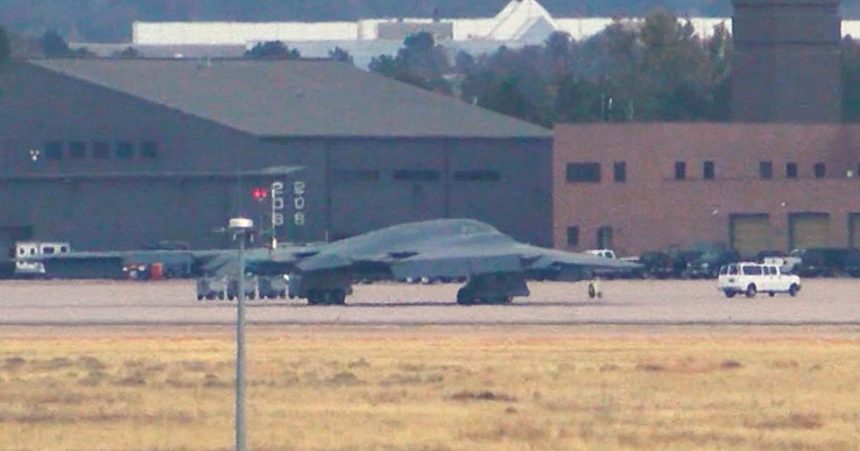Official Investigation Pending. Internet Buzzing with Speculation About Cause.
A U.S. Air Force B-2 Spirit stealth bomber made an emergency landing on Tuesday, Oct. 23, 2018 at the Colorado Springs Airport following an unspecified inflight incident.
A number of local photographers have posted photos of the aircraft sitting on the tarmac at the joint use civilian/military airport located about 12 miles from downtown Colorado Springs.
An Air Force statement from Brig. Gen. John J. Nichols, 509th Bomb Wing commander, read, “Our aviators are extremely skilled; they’re trained to handle a wide variety of in-flight emergencies in one of the world’s most advanced aircraft and they perfectly demonstrated that today.”
Numerous media outlets and local news reports have said the two crewmembers on board the aircraft were not injured in the incident.
The incident is unusual since there are only 18 known B-2s currently in operation with one additional aircraft allocated for dedicated testing purposes (and one crashed 10 years ago). The 18 operational aircraft are flown by the historic U.S. Air Force 509th Bomb Wing at Whiteman AFB, Missouri.
The unit is descended from the 509th Composite Group, the only aviation unit in the world to operationally employ nuclear weapons in combat using B-29 Superfortresses during the 1945 airstrikes on Hiroshima and Nagasaki.
The 509th Bomb Wing and its Northrop Grumman B-2 Spirit are critical U.S. strategic strike assets. The loss of one aircraft, even if temporary, reduces the global precision low-observable strike capability by 5.5%. Because the aircraft have previously initiated ultra-long range strikes directly from their home base at Whiteman AFB, this reduction in capability is noteworthy.
Social media posts on Facebook shared parts of what is claimed to be radio communications from local air traffic control facilities during the incident. In the recordings, the controller is heard saying, “There is another issue with the aircraft coming in, they are unable to change radio frequencies”. The same tape also says the local fire department at the airport was called.
The B-2 was initially directed to runway 17L but actually landed on runway 35R, a runway at 6,134 feet of elevation that is 13,500 feet long, the longest runway available at Colorado Springs Airport.
The tower controller in the audio relays that, “I’m just relaying through Denver Center, all of the information, but as far as I now it is just the number 4 engine out”. Tower control finally says that he is unable to talk to the aircraft and is going to use a light gun to signal the aircraft, “But I am unable to talk to them. I’m just going to give them the light gun.” What appears to be an additional controller in the communications says, “No, they were unable to switch radio [frequencies] to me. I could only give them the light gun.”
Emergency response team on scene provided the pilot with oxygen, according to the reports but the reason for administering oxygen is unclear and subject to speculations.
On the other side, analysis of the (unusual) back shots of the aircraft: the U.S. Air Force usually prevents shorts at the rear of the aircraft.
“Photos taken of the B-2 on the ramp in Colorado show the aircraft’s auxiliary air inlet doors open on the left side and closed on the right. This is unusual. We don’t know if the right-side inlet doors were stuck closed during landing—they are open during terminal phases of flight—or if the left side failed to close upon shutting down,” Tyler Rogoway at The War Zone noticed.
As of Wednesday afternoon, on October 24th, plane spotters in the area have since reported the B-2 is “gone”. The aircraft was not seen departing the airport so it is probable it has been moved discreetly to an indoor hangar.
On February 26, 2010, a somehow similar incident occurred with a B-2 Spirit stealth bomber forward deployed in Guam. The aircraft aborted a takeoff with an engine fire. The official USAF spokesperson for the incident at the time, then- Lt. Col. Kenneth Hoffman, characterized the incident as “minor”. A subsequent report published on January 6, 2014 in “War Is Boring” by writer David Axe went on to reveal the B-2 involved in that incident received more than minor damage. It took over two years to return the aircraft to operational flying condition.
Each of the B-2 spirit fleet aircraft has a name designated by state. In the case of the February 26, 2010 incident, the aircraft involved was the “Spirit of Washington”, aircraft number 88-0332. The photos from yesterday’s incident may show aircraft number 89-0128, the “Spirit of Nebraska” being involved in Tuesday’s emergency landing.
The future of the small and crucial B-2 fleet will certainly be influenced by the ability to maintain existing aircraft and repair any aircraft damaged in normal operations.
As the B-2 fleet continues to age and remain exposed to normal operational attrition the new, secretive B-21 Raider is expected to assume the low-observable strategic strike mission as it comes on line as early as 2025. Basing options for the B-21 Raider were announced earlier this year and could include Dyess Air Force Base in Texas, Ellsworth Air Force Base in South Dakota and Whiteman Air Force Base in Missouri as “reasonable alternatives ” to base the new B-21 bomber. These facilities already host strategic bomber assets including the B-1B Lancer long-range, supersonic heavy bomber.
The B-1B is also expected to be phased out in conjunction with the introduction and operational integration of the B-21 Raider. The plans for the B-21 Raider fleet include significantly more aircraft than the operational B-2 Spirit program with some estimates suggesting as many as “100-200” B-21 Raiders could be built. The unit cost of the B-21 could be half the single aircraft cost of the B-2 partially because the B-21 Raider will share the Pratt & Whitney F135 engine with the F-35 Joint Strike Fighter program.
Top image credit: Air Force amn/nco/snco FB page.









